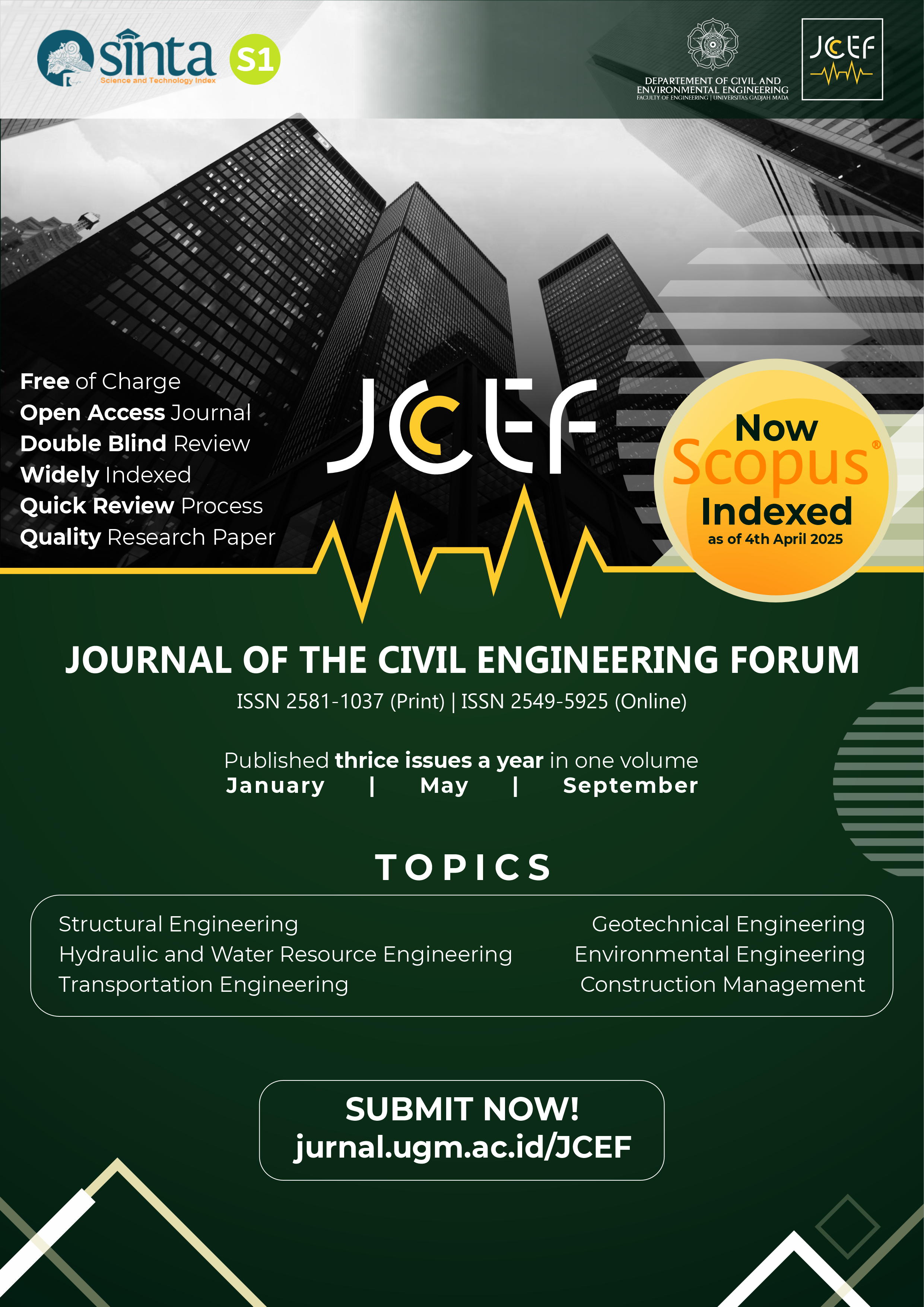Effect of Micro-Pile Mitigation on Seismic Performance of Liquefiable Ground
Abstract
Soil liquefaction and its associated ground failures, pose a significant threat, causing damage to engineering structures during earthquakes, and one of the most effective methods used to mitigate liquefaction in liquefied soil is micro-pile (MP) method. Therefore, this study aims to examine the current state of MP method as liquefaction countermeasure in the soil of the Coal Fired Power Station in Central Java, an area with a high liquefaction potential. A three-dimensional finite element analysis, conducted with OpenseesPL software, uses a numerical method to yield information about ground lateral deformation and excess pore pressure generation caused by MP method during seismic shaking. This result examines important design parameters, including diameter, spacing, length of MP, and inclination of ground, to address these issues. MP method increases the stiffness of soil, reducing excessive pore pressure and thereby minimizing liquefaction risks. In general, MP remediation appeared effective for any sloping ground. This study provides valuable information for devising an efficient remediation solution by comparing relevant variables, such as diameter, spacing, MP length, and ground inclination, under the same conditions. Numerical simulation with OpenseesPL yields results such as stress and strain path, acceleration time histories, excess pore pressure, displacement time histories, and maximum lateral displacement, which are then compared with various diameter parameters. The diY6-ameter parameters were compared to test how the additional diameter dimension affects the performance of the micropile provided to the soil. This will be demonstrated based on the results shown on excess pore pressure and maximum lateral displacement. This comparison shows that increasing MP diameter is more effective in reducing the risk of liquefaction.
References
Asgari, A., Oliaei, M. and Bagheri, M. (2013), ‘Numerical simulation of improvement of a liquefiable soil layer using stone column and pile-pinning techniques’, Soil Dynamics and Earthquake Engineering 51, 77–96.
Ashford, S. A. et al. (2000), ‘Liquefaction mitigation using stone columns around deep foundations: Full-scale test results’, Transportation Research Record (1736), 110–118.
Bird, J. F. and London, I. C. (2005), The principles of liquefaction, in ‘Encyclopedia of Geology’, p. 525–534.
Brier, J. and Jayanti, L. D. (2020), ‘Micropiles for structure foundations’, Journal Name 21, 1–9.
Correia, A. M. and Silva, V. P. (2010), ‘Numerical study on the behavior of steel columns’, Sepideh Damavandinejad Monfared.
Fan, R. et al. (2020), ‘Study on the bearing capacity of micropiles in plateau mountainous area: A case study of a power supply project in a traction station in sichuan’, IOP Conference Series: Earth and Environmental Science 560(1).
Fattah, M. Y. and Salim, N. (2018), ‘Effect of pile diameter on the behavior of fully plugged pipe pile group in sandy soil’, ASEC conference in Jordan.
Forcellini, D. and Tarantino, A. M. (2014), ‘Assessment of stone columns as a mitigation technique of liquefaction-induced effects during italian earthquakes (may 2012)’, The Scientific World Journal.
Gogoi, N., Bordoloi, S. and Sharma, B. (2014), ‘A model study of micropile group efficiency under axial loading condition’, International Journal of Civil Engineering Research 5(4), 323–332. URL: http://www.ripublication.com/ijcer.htm.
Haghighy, P. (2017), ‘Improving the bearing capacity of foundations using micropiles’, International Journal of Advances in Scientific Research and Engineering 03(2), 38–46. URL: http://www.ijasre.net/uploads/1/2802pdf:pdf
Huang, D., Wang, G. and Jin, F. (2020), ‘Effectiveness of pile reinforcement in liquefied ground’, Journal of Earthquake Engineering 24(8), 1222–1244.
Huang, Y. et al. (2008), ‘Numerical simulation of mitigation for liquefaction-induced soil deformations in a sandy ground improved by cement grouting’, Environmental Geology 55(6), 1247–1252.
Juran, I., Benslimane, A. and Hanna, S. (2001), ‘Engineering analysis of dynamic behavior of micropile systems’, Transportation Research Record (1772), 91–106.
Lu, J., Kamatchi, P. and Elgamal, A. (2019), ‘Using stone columns to mitigate lateral deformation in uniform and stratified liquefiable soil strata’, International Journal of Geomechanics 19(5), 1–13.
Malik, B. A., Shah, M. Y. and Sawant, V. A. (2021), ‘Influence of micropile parameters on bearing capacity of footings’, Environmental Science and Pollution Research 28(35), 48274–48283.
Pitroda, J. and Bhavsar, J. J. (2015),‘Micro-pile: Recent advances and future trends’, Journal Name 11.
Rashma, R. S. V., Jayalekshmi, B. R. and Shivashankar, R. (2022), ‘Liquefaction mitigation potential of improved ground using pervious concrete columns’, Indian Geotechnical Journal 52(1), 205–226.
Seed, H. B. and Idriss, I. M. (1971), ‘Simplified procedure for evaluating soil liquefaction potential’, Journal of the Soil Mechanics and Foundations division 97(9), 1249–1273.
Sharma, B., Sarkar, S. and Hussain, Z. (2019), A study of parameters influencing efficiency of micropile groups, in ‘Lecture Notes in Civil Engineering’, Vol. 14, p. 11–18.
Tang, L. et al. (2015), ‘Numerical study on ground improvement for liquefaction mitigation using stone columns encased with geosynthetics’, Geotextiles and Geomembranes 43(2), 190–195.
Thevanayagam, S. and Martin, G. R. (2002), ‘Liquefaction in silty soils - screening and remediation issues’, Soil Dynamics and Earthquake Engineering 22(9–12), 1035–1042.
Copyright (c) 2024 The Author(s)

This work is licensed under a Creative Commons Attribution-ShareAlike 4.0 International License.
Copyright is granted to authors for the purpose of providing protection for articles written to describe experiments and their results. JCEF will protect and defend the work and reputation of the author and are also willing to address any allegations of violation, plagiarism, fraud, etc. against articles written and published by JCEF. JCEF is published under the terms of the Creative Commons Attribution-ShareAlike 4.0 International License (CC BY-SA 4.0). The author holds the copyright and assigns the journal rights to the first publication (online and print) of the work simultaneously.





